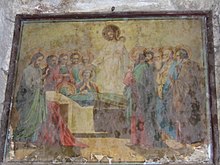Orhei District
This article includes a list of general references, but it lacks sufficient corresponding inline citations. (June 2013) |
Orhei | |
|---|---|
District (Raion) | |
 | |
|
UTC+3 (EEST) | |
| Area code | +373 35 |
| Car plates | OR |
| Website | www.or.md |
Orhei (Romanian pronunciation:
History

The Orhei region has been inhabited since the
Geography

The district is located in the central part of the
- The Central Moldavian Plateau (forest), in the northeast, combines narrow, deep valleys and broad slopes.
- The northern plain was created by soil erosion. This area has the lowest altitude (200–250 metres (660–820 ft)), crossing the Răut and Cogâlnic rivers from north to south. The Răut Valley covers about 6,500 hectares (25 sq mi), primarily privately owned pasture.
- The terraced Nistrului Plateau is at an altitude of 250–300 metres (820–980 ft), with dips of 150–200 metres (490–660 ft). The western slope is gradual, with the east sloping more sharply towards the Dniester.
Climate
The district has a
Fauna

Mammals in the region include foxes, deer, red deer, wild boars, hedgehogs, badgers, rabbits, and wolves. Birds include crows, hawks, partridges, storks, and jays.
Flora
Forests occupy 20.1% of the district (24,277 hectares). Tree
.Protected areas
There are nature reserves in Susleni, Pohrebeni and Trebujeni.
Hydrosphere

Rivers in the district include the
Administrative subdivisions

- Localities: 75
- Administrative center: Orhei
- City: Orhei
- Communes: 37
- Villages: 37
Demographics
In January 2012 the district population was 125,800, with 26.6 percent in urban and 73.4 percent in rural areas.
- Births (2010): 1,521 (12.1 per 1,000)
- Deaths (2010): 1,694 (13.5 per 1,000)
- Growth Rate (2010): -173 (−1.4 per 1,000)
Ethnic groups
Ethnic group |
% of total |
|---|---|
| Moldovans * | 86.5 |
| Romanians * | 8.8 |
| Ukrainians | 3.0 |
| Russians | 1.3 |
| Gagauz | 0.1 |
| Bulgarians | 0.1 |
| Romani | 0.1 |
| Other | 0.3 |
| Undeclared | 0.17 |
Footnote: * There is an ongoing controversy regarding the ethnic identification of Moldovans and Romanians.
Religion
- Christians – 98.4%
- Orthodox Christians– 97.6%
- Protestant– 0.8%
- Baptists – 0.4%
- Seventh-day Adventists– 0.2%
- Evangelicals– 0.2%
- Other – 1.2%
- None 0.4%
Economy

There are 40,693 registered businesses in the district. Fifty-seven are public companies, 4,606 are privately owned, 40 have mixed public-and-private ownership and 14 are foreign-owned. Manufacturing and agriculture are the dominant sectors of the district economy. There are 30 industrial companies: 27 manufacturers and three mines. In 2009, there were 2,496 unemployed workers. Agricultural land comprises 82,238 ha (67 percent) of the total area.
Education
The Orhei district has 69 educational institutions, and the total number of students is 15,160. There are 1,448 students in teachers' and medical colleges, and 685 students in
Politics
The Orhei district has traditionally favored
| Year | AEI | PCRM |
|---|---|---|
| 2010 | 68.77% 40,344 | 24.25% 14,227 |
| July 2009 | 64.40% 34,880 | 29.51% 15,982 |
| April 2009 | 37.80% 20,115 | 39.37% 20,952 |
Elections
| Parties and coalitions | Votes | % | +/− | |
|---|---|---|---|---|
| Liberal Democratic Party of Moldova | 21,991 | 37.49 | +16.71 | |
| Party of Communists of the Republic of Moldova | 14,227 | 24.25 | −5.26 | |
Democratic Party of Moldova
|
9,972 | 17.00 | +0.07 | |
| Liberal Party | 5,758 | 9.81 | −8.93 | |
Party Alliance Our Moldova
|
2,623 | 4.47 | −3.48 | |
European Action Movement
|
773 | 1.32 | +1.32 | |
| Other parties | 3,346 | 5.66 | -0.43 | |
| Total (turnout 61.05%) | 59,118 | 100.00 |
| |
Culture

The district has five museums, 60 public libraries and 62 community centres.
Health
Orhei District has a 430-bed hospital, a family-health center, 33 family practitioners' offices, 14
Notable residents

- Alecu Donici – Poet, storyteller and translator
- David Knut– Russian poet
- Iurie Platon – Russian painter and sculptor
- Argentinepoet
- Meir Dizengoff – Politician and first mayor of Tel Aviv
- Paul Goma – Writer and anticommunist militant
- Sergey Lazo – Communist militant during the Russian Civil War, Siberia and the Far East
- Basarabiain 1920–1921, 1926–1927
References
- ^ "Results of Population and Housing Census in the Republic of Moldova in 2014". National Bureau of Statistics of the Republic of Moldova. 2017. Retrieved 1 May 2017.
- ^ "Results of Population and Housing Census in the Republic of Moldova in 2014". National Bureau of Statistics of the Republic of Moldova. 2017. Retrieved 1 May 2017.
- District population per year[permanent dead link]
- Results of 2010 Parliamentary Election
- General description of the orhei district
- District site
